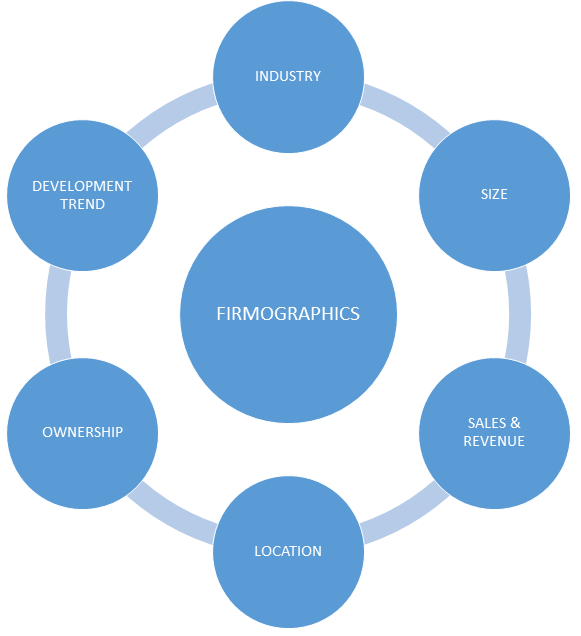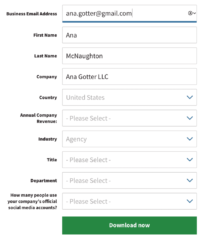B2B visitors are hard to please. Even when they’re sure about a proposition, most of them would still abandon without signing up if there is even a speck of doubt or skepticism in their minds. Predicting their behavior and motivation, therefore, is a tough nut to crack. What if you could figure out which of your website’s anonymous users are qualified or high-ticket, and what they’re interested in?
You’d simply direct these visitors to Sales Development Reps, offer them information they’re interested in, and eliminate barriers like long sign-up forms by inviting them to a demo. You’d also focus the majority of your resources on high-value visitors while retargeting and nurturing them to keep client acquisition costs low.
Is it a hypothetical assumption to please oneself, or an achievable goal? Let’s find out.
What is firmographic data?

Firmographic data focuses on organizations in order to collect and evaluate crucial information about how businesses operate. Examples of common firmographic data include:
Type of Industry: Organizations can be segmented based on the type of industry they belong to. It is, however, important to note that there can be businesses that operate in more than one industry. Such businesses will come under more than one firmographic segment.
Size of the organization: Based on its infrastructure and the number of employees, firmographic segmentation of an organization can give useful insights.
Annual sales and revenue: When it comes to assessing the types of businesses you are attracting, looking at the financials of your prospects might be helpful. You don’t want to waste your time and resources targeting businesses that can’t afford what you’re offering, so knowing the net worth can help you sort out those who aren’t likely to buy, allowing you to focus on those who are.
Location: Another key type of segmentation is based on where your consumers are located. This might be as specific as a city or state, or it can be as broad as a country or continent. Knowing this information will help you decide where to concentrate the majority of your marketing efforts, or it may indicate that you need to step up your game in particular geographic areas.
Type of ownership: This segmenting is based on whether the organization comes under the public sector or private sector; is a charitable or a non-profit organization, or an NGO. This firmographic is vital because each ownership framework has a unique marketing strategy associated with it.
Development trend: An organization might be expanding, contracting, or retaining its present market position. The firmographic in this respect has to be treated differently, since the strategy for them are quite different from one another.
Technology stack of an organization may also, sometimes, come under firmographics. But due to its inherent complexity and enormity, organizations segmented based on the technology usage fall under what is known as technographics data.
Acquiring Firmographic Data
There are three ways in which you can gather firmographic data:
1. Survey the companies directly
Although direct surveying is a reliable source and may provide you the authentic data, there are many organizations that refrain from sharing information, especially in these times when data breach and mishandling have become common. The result is that you’ll mostly have incomplete data at your disposal, but if the organization is ready to share information, this is one of the most cost-effective source of firmographic data.
The following is a survey form from a reputed organization who are using it to obtain firmographic data from the visitors of their site.

Source: Hootsuite
2. Perform online search
Meanwhile, online searches can bring up a wealth of relevant firmographic data, but there’s no guarantee of its quality or relevance; the usefulness of data gained this way is highly dependent on the source and the date it was obtained.
The result is that you’ll have ample data at your disposal, but a major chunk of it will be unreliable and stale.
3. Avail the service of firmographic data providers
Buying data from a professional and trustworthy database vendor is the most accurate and up-to-date choice. You must, however, do the ‘price and value’ analysis—“what’s the value of the firmographic data at a certain price?” is the question for which you must have a clear-cut answer.
Leveraging Firmographic Data
With reliable firmographic information, you can boost your entire sales and lead generating funnel to ameliorate your sales and marketing efforts. You must keep yourself geared up with the following four strategies:
1. Determine the different types of people you’re attracting
You’ll notice different trends emerge as you begin to collect more data on your leads and clients. These will assist you in identifying and better defining the different audience segments that you’re attracting.
2. Make your messaging and offers more relevant
It becomes easy to produce more relevant messaging and offers on your site once you know who your target audience is.
3. Marketing Campaigns & Targeting Should Be Improved
Understanding how to use outbound and inbound marketing techniques to reach high-value marketing categories is critical, and firmographic data can help tremendously.
4. Lead Scoring helps you qualify, identify, and convert leads
Once you’ve the new leads at your disposal from your fruitful marketing campaigns, you can use the same firmographic data you used to build the lead generation funnel to now help you convert those leads into customers.
Wrapping it up
B2B firms can benefit from timely, reliable, and actionable firmographic data to develop personalized sales and marketing strategies and enhance overall conversion rates. They must focus on both segmentation forms and decision-making activities to guarantee firmographic frameworks achieve desired results. By minimizing the time between information and action, companies can enhance the sales performance by accurately segmenting prospecting data based on firmographics, and then leveraging this data to influence sales and marketing efforts.


